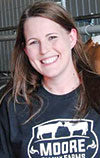“Give it to me straight, Heather,” the post read. “Lucy is still breastfeeding, but we’re starting to think about transitioning her to whole milk in a few months. I’m worried about extra hormones. Should I be looking for hormone-free milk? Or should I just be buying it for her when she’s old enough?”
Ellen, a well-educated professional living in the suburbs of a large city, had posted this question to me in a social media group dedicated to 20- and 30-somethings with similar interests. I’m the only farmer.
Penny, an urban West Coast mother of two, chimed in: “I’m not so much worried about hormones. It’s the antibiotics. But organic milk is so expensive.”
As I began to type, I kept a few tips in mind:
1. Relate to the consumer
Work to find the motivation behind the questions. I typically talk to mothers who are trying to make the best choices for their families. Explaining that dairy farmers do what is best for their cows seems to inspire a light bulb moment. I often compare different farmers utilizing different farming philosophies to parents having different parenting philosophies.
2. Match their concern
Don’t respond to emotional questions with a purely scientific response. Address the emotional aspect first, then move on to the scientific or financial aspect of the practices. Many times, I feel that farmers are afraid to reveal the emotion they have tied to their animals and their industry. Meanwhile, many consumers are using emotion to make their decisions about farming. As Theodore Roosevelt once said, “People don’t care how much you know, until they know how much you care.”
3. You don’t have to speak on behalf of the entire industry
Talk about what you know best – your own farm. You don’t have to talk about the neighbor’s farm down the road, or the 1,000-cow dairy in the next county. It’s okay to say, “I’m not sure about their practices, but our philosophy is ...”
4. It’s okay to (respectfully) disagree
You don’t have to defend farming practices that you don’t believe in, as long as you are able to do it respectfully. We chose to build a small tiestall barn, and obviously our cows live a much different life than cows on large farms with freestalls. Just because my farming beliefs and practices are different than the dairymen and women operating large farms doesn’t mean that I don’t respect them and what they do. There are places in our industry for both types of operations, and I explain my choices without throwing other farms under the bus.
5. Let the experts do your talking
I wish I could recall all the statistics and science behind the dairy industry at the drop of a hat. I also wish I could remember what day it is without looking at my calendar every morning (and afternoon, and sometimes evening). But, I can’t. So that’s why I rely on the experts. I often direct people to blogs or other resources that have all the numbers and better (and more precise) explanations than what I can give at any moment. I also feel that utilizing the best sources provides a unified voice across our industry and ensures the best and most accurate information is in the hands of consumers. My favorite blogs to refer folks to are Dairy Carrie, who does an excellent job of providing straightforward information and addressing consumer concerns head on, and Modern Dairy Farm Chick, which showcases life on a larger dairy farm.
6. Don’t fight a losing battle
The odds are that a vegan animal rights activist isn’t going to convince you that milking dairy cows is inhumane. You have the same odds of convincing them that milking dairy cows is humane. It’s okay to (again, respectfully) agree to disagree and end the conversation.
7. Open up your farm
You don’t have to host the county’s dairy breakfast to make a big impact on a consumer. Simply inviting a friend or neighbor with questions out to see your farm or to feed a calf can make all the difference. Last summer our sons’ friends visited our farm to “see the big cows” and feed the baby calves. Nearly a year later, the 3-year-old tells me that he is going to come again to feed calves and let the cows out again.
I answered Ellen and Penny’s questions, and it actually sparked a great conversation in the group about farming practices and food science.
A few weeks later, another notification showed up in my newsfeed. I groaned inwardly as I saw that a viral anti-farming video had been posted to the group’s wall – until I saw the comments. “Can you believe this? Obviously these people have no idea what happens on a real dairy farm! They need to talk to a farmer!” PD
Heather Moore is a dairy farming mama herself, raising two little boys (and a third on the way!) with her husband, Brandon. The Moore family has a 50-cow dairy and custom feeds 800 head of beef cattle near Maquoketa, Iowa. When she is not chasing around cows and kids, you'll find her volunteering, cooking and very occasionally, sleeping.
PHOTO: One of the best ways to educate others on the safety and quality of milk is to open up your farm for a tour. Here, Heather Moore explains to a curious young child the path milk takes from the cow to the dairy case. Photo provided by Heather Moore.






